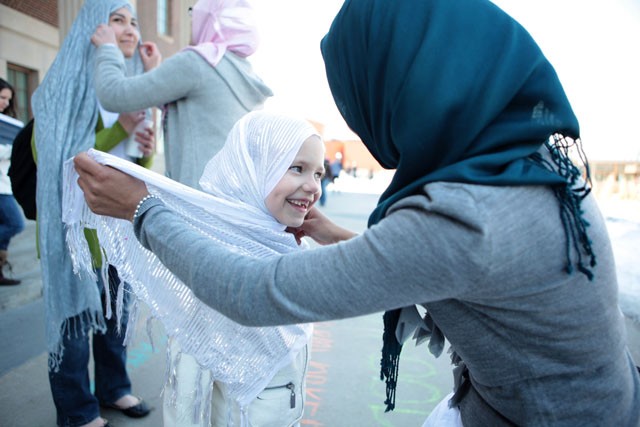When 6-year-old Olivia Trembley was younger, getting a glimpse of a woman wearing the hijab, a traditional Muslim headscarf, was like being in the presence of royalty.
âÄúShe used to think the headscarf meant they were princesses,âÄù her mother, Sarah Trembley, said.
Both mother and daughter learned the true meaning behind the hijab when they participated in the Hijabi for a Day event Wednesday as part of the annual Islam Awareness Week hosted by Al-Madinah Cultural Center and the Muslim Student Association.
Members of the student organizations provided more than 100 free scarves in front of Coffman Union to non-Muslim women âÄî and even men âÄî willing to wear the traditional covering for the day.
âÄúI really like it,âÄù Olivia Trembly said as she looked at herself in the mirror after her blonde hair was tucked under a white, beaded scarf to match her outfit. âÄúI look good.âÄù
Sabah Khatoon, a member of the Islam Awareness Week Committee, said the event is hosted to draw attention to the significance of the veil, combating the perpetuation of misconceptions and assumptions about Muslim women.
Volunteers explained the meaning behind the hijab and answered questions as they helped participants pick scarves and put them on.
âÄúUnlike most people think, the point is not to hide ourselves because we are lesser,âÄù said Ariel Schwarz, a recent convert to Islam who does not regularly choose to veil outside of prayer but participated in the event. âÄúThe point is not flaunting our outer beauty, so that our inner beauty shines through.âÄù
âÄòWalk confidentlyâÄô
After Malaysy Phothisane walked away from the Hijabi for a Day table wearing her sequined, tan headscarf, she said she immediately noticed a change in how people looked at her.
âÄúI felt like I was being looked at for a longer period of time than usual,âÄù the sociology student said. âÄúIt was more than the glances I was used to.âÄù
Her feelings culminated after she entered the Martin Luther King, Jr. Program advising office, where she frequently goes to study, and realized the woman at the front desk had never noticed her until that moment.
âÄúThe thing IâÄôll take away is that you have to walk confidently no matter what youâÄôre wearing,âÄù she said. âÄúDonâÄôt allow people to treat you differently or stigmatize you. ItâÄôs the only way we can embrace diversity on this campus.âÄù
Maintaining an open mind
Daisha Jensen had an exam in deformable body mechanics only a few hours after the event but decided to participate in the Hijabi for a Day event after being urged by many of her Muslim friends.
Though she did not notice much of a difference in how others looked at her, the experience made her aware of some things she never considered when thinking about the choice to veil.
âÄúIt made me think about what other people go through every day,âÄù she said, âÄúthings as simple as getting dressed.âÄù
When her scarf fell off before her exam, she had no idea how to put it back on and had to take it off.
The biomedical engineering major said the experience made her realize the importance of an open mind.
âÄúI was glad I did it,âÄù she said. âÄúIt reaffirmed that IâÄôm an open-minded person. You have to try as hard as you can to learn and understand other experiences better âĦ IâÄôm definitely going to research the hijab more.âÄù
A campus âÄòin the knowâÄô
When a striped, navy blue hijab was pinned around Erin KelleyâÄôs head, she had no idea what to expect out of the rest of her busy day.
However, she was surprised to discover how well she was received by her peers. When one of her classmates looked at her strangely, she explained she was participating in awareness week.
âÄúTurns out, she had participated last year,âÄù Kelley said. âÄúPeople around here are definitely more in the know than you would expect.âÄù
Welcome questions
Mariam Mahmood and Sabah Khatoon have gotten plenty of questions about their choice to wear the hijab âÄî or, as they describe it, âÄúto veil.âÄù
They said they have been asked about everything from whether they wear the scarves in the shower to whether or not they are bald underneath their hijab. For the record: They donâÄôt, and they arenâÄôt.
Despite these unusual inquiries, both agree that the beauty of Islam Awareness Week and the Hijabi for a Day event lies in the opportunity for non-Muslims to ask questions in an open environment.
âÄúI want people to ask rather than assuming,âÄù Khatoon said. âÄúIf they did, it would erase a lot of misconceptions about women in Islam.âÄù
When Andrew Steffenhagen approached the table sipping his Jamba Juice, he took the open invitation to ask away. Steffenhagen started by asking the technical term for the covering and worked his way to more personal questions, asking whether women were required to wear the hijab by their husbands or fathers. Khatoon patiently answered all of his questions.
âÄúI donâÄôt feel like IâÄôm informed,âÄù Steffenhagen, one of a handful of males who participated in the event by wearing a scarf, said. âÄúIâÄôve been wondering about this for a while, but I donâÄôt have a lot of friends who identify as Muslim to ask.âÄù
Khatoon said SteffenhagenâÄôs questions made her happy and she hopes the open dialogue between Muslims and non-Muslims continue through the rest of Islam Awareness Week and beyond.
âÄúAfter learning a little bit more about the hijab, I think itâÄôs kind of cool,âÄù Steffenhagen said, before walking to class in his black headscarf. âÄúI love that these women have this much dedication to their religion. I donâÄôt have that type of dedication in any part of my life.âÄù

Image by Erin Westover
Unveiling truth behind the hijab
Student groups used Islam Awareness Week to dispel myths about the headscarf.
Published March 31, 2011
0

